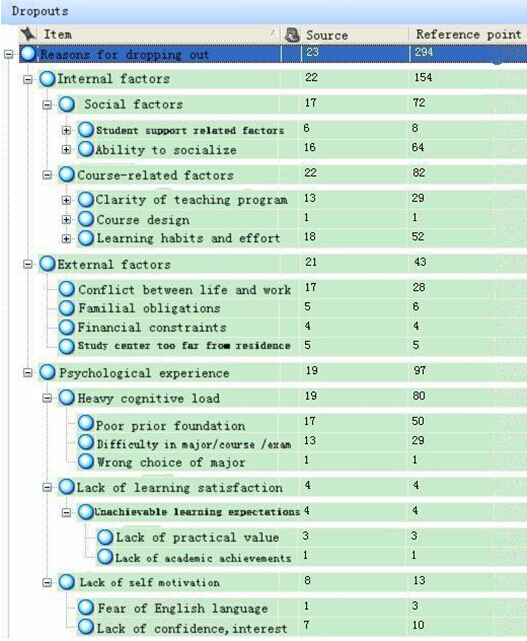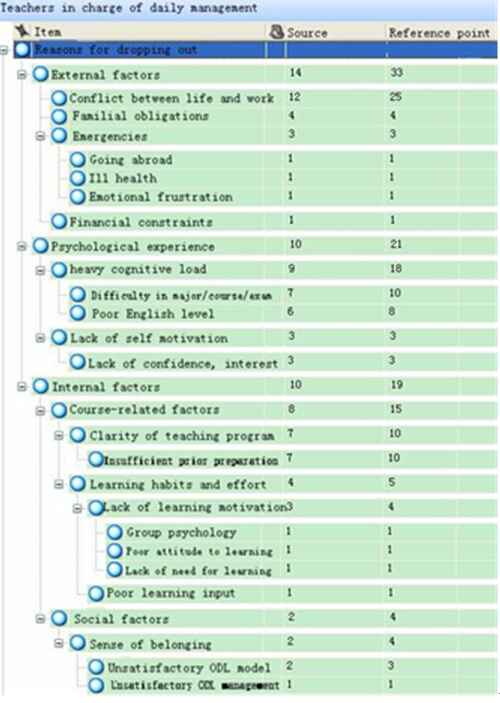2.1.2 After enrollment
A Dropouts in the first semester
Figures two to five show a dropout attribution code pattern derived from interviews with first semester bachelor’s degree programme dropouts, related professional tutors and teaching assistants. Figure three reflects “Internal Factors Closely Related to ODL Institutions”. From Figures two, four and five we can see that dropouts, professional tutors and teaching assistants have different views on the reasons contributing to drop outs, such as internal factors, psychological experience and external factors. For dropouts (Figure two), in spite of various external factors, such as conflict between work and study (reference point 43), what really prompts them to drop out is a lack of sense of belonging to university life (reference point 154) which gives rise to a negative psychological experience, such as a heavy mental load and poor self-efficiency (reference point 97). Professional tutors (Figure four) emphasize the dropouts’ heavy cognitive load (reference point 37), which to a great extent arises from poor prior knowledge and skills (reference point 21). They also draw attention to external factors, such as conflict between work and study (reference 11). Teaching assistants (Figure five) are deeply aware of the influence of external factors on dropouts,, such as busy life and work (reference point 33). They are also fully aware of dropouts’ heavy cognitive load (reference point 18) and poor prior knowledge (reference point 10). Figure three reveals the dropouts’ learning activities after enrollment, demonstrating a lack of interaction with professional tutors (reference point 64), lack of learning input (reference point 37), poor prior knowledge and skills (reference point 29) and lack of learning motivation (reference point 11).

Figure 2 Dropout attribution code pattern for the first semester (dropouts from the bachelor’s degree programme)

Figure 3 Dropout attribution (internal factors) code pattern for the first semester (dropouts from the bachelor’s degree programme)

Figure 4 Dropout attribution code pattern for the first semester (bachelor’s degree programme professional tutors)

Figure 5 Dropout attribution code pattern for the first semester (teaching assistants of the bachelor’s degree Programme)
B Reasons for dropouts over the three semesters
We have drawn three dropout attribution code patterns for the three semesters observed. Owing to limited space, we are only able to present a comparison of the reasons for dropping out (see Table four). Figures six to eight were formulated based on Table four. Figure six reveals that from the perspective of the dropouts themselves, external factors aside, what makes them dropout is a lack of sense of belonging to university life and a negative psychological experience, such as heavy cognitive load. Figure seven indicates that from the perspective of the professional tutors, a negative psychological experience, such as heavy cognitive load, plays a vital role in dropout rates. They also point to internal factors closely related to university life, followed by external factors. Figure eight shows that the teaching assistants emphasize the influence of external factors, such as conflict between their work and their study. Overall, the reasons driving dropout rates across the semesters observed are very similar: dropouts emphasize a lack of sense of belonging to university life, professional tutors stress a heavy cognitive load and the teaching assistants underline the influence of external factors.